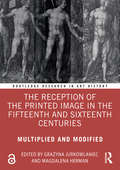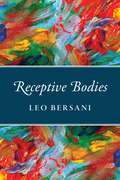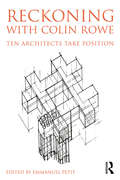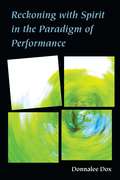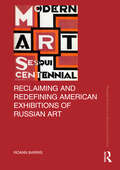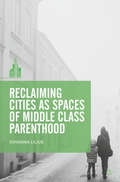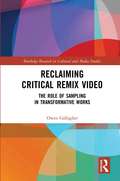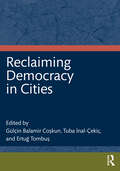- Table View
- List View
The Reception of the Printed Image in the Fifteenth and Sixteenth Centuries: Multiplied and Modified (Routledge Research in Art History)
by Gra 380 Yna Jurkowlaniec Magdalena HermanThis book examines the early development of the graphic arts from the perspectives of material things, human actors and immaterial representations while broadening the geographic field of inquiry to Central Europe and the British Isles and considering the reception of the prints on other continents. The role of human actors proves particularly prominent, i.e. the circumstances that informed creators’, producers’, owners’ and beholders’ motivations and responses. Certainly, such a complex relationship between things, people and images is not an exclusive feature of the pre-modern period’s print cultures. However, the rise of printmaking challenged some established rules in the arts and visual realms and thus provides a fruitful point of departure for further study of the development of the various functions and responses to printed images in the sixteenth century. The book will be of interest to scholars working in art history, print history, book history and European studies. The introduction of this book is freely available as a downloadable Open Access PDF under a Creative Commons Attribution-Non Commercial-No Derivatives 4.0 license at https://www.taylorfrancis.com/chapters/oa-edit/10.4324/9781003029199-1/introduction-gra%C5%BCyna-jurkowlaniec-magdalena-herman?context=ubx&refId=b6a86646-c9f3-490d-8a06-2946acd75fda
The Reception of the Printed Image in the Fifteenth and Sixteenth Centuries: Multiplied and Modified (Routledge Research in Art History)
by Grażyna JurkowlaniecThis book examines the early development of the graphic arts from the perspectives of material things, human actors and immaterial representations while broadening the geographic field of inquiry to Central Europe and the British Isles and considering the reception of the prints on other continents. The role of human actors proves particularly prominent, i.e. the circumstances that informed creators’, producers’, owners’ and beholders’ motivations and responses. Certainly, such a complex relationship between things, people and images is not an exclusive feature of the pre-modern period’s print cultures. However, the rise of printmaking challenged some established rules in the arts and visual realms and thus provides a fruitful point of departure for further study of the development of the various functions and responses to printed images in the sixteenth century. The book will be of interest to scholars working in art history, print history, book history and European studies. The introduction of this book is freely available as a downloadable Open Access PDF under a Creative Commons Attribution-Non Commercial-No Derivatives 4.0 license at https://www.taylorfrancis.com/chapters/oa-edit/10.4324/9781003029199-1/introduction-gra%C5%BCyna-jurkowlaniec-magdalena-herman?context=ubx&refId=b6a86646-c9f3-490d-8a06-2946acd75fda
Receptive Bodies
by Leo BersaniLeo Bersani, known for his provocative interrogations of psychoanalysis, sexuality, and the human body, centers his latest book on a surprisingly simple image: a newborn baby simultaneously crying out and drawing its first breath. These twin ideas—absorption and expulsion, the intake of physical and emotional nourishment and the exhalation of breath—form the backbone of Receptive Bodies, a thoughtful new essay collection. These titular bodies range from fetuses in utero to fully eroticized adults, all the way to celestial giants floating in space. Bersani illustrates his exploration of the body’s capacities to receive and resist what is ostensibly alien using a typically eclectic set of sources, from literary icons like Marquis de Sade to cinematic provocateurs such as Bruno Dumont and Lars von Trier. This sharp and wide-ranging book will excite scholars of Freud, Foucault, and film studies, or anyone who has ever stopped to ponder the give and take of human corporeality.
Receptive Bodies
by Leo BersaniLeo Bersani, known for his provocative interrogations of psychoanalysis, sexuality, and the human body, centers his latest book on a surprisingly simple image: a newborn baby simultaneously crying out and drawing its first breath. These twin ideas—absorption and expulsion, the intake of physical and emotional nourishment and the exhalation of breath—form the backbone of Receptive Bodies, a thoughtful new essay collection. These titular bodies range from fetuses in utero to fully eroticized adults, all the way to celestial giants floating in space. Bersani illustrates his exploration of the body’s capacities to receive and resist what is ostensibly alien using a typically eclectic set of sources, from literary icons like Marquis de Sade to cinematic provocateurs such as Bruno Dumont and Lars von Trier. This sharp and wide-ranging book will excite scholars of Freud, Foucault, and film studies, or anyone who has ever stopped to ponder the give and take of human corporeality.
Receptive Bodies
by Leo BersaniLeo Bersani, known for his provocative interrogations of psychoanalysis, sexuality, and the human body, centers his latest book on a surprisingly simple image: a newborn baby simultaneously crying out and drawing its first breath. These twin ideas—absorption and expulsion, the intake of physical and emotional nourishment and the exhalation of breath—form the backbone of Receptive Bodies, a thoughtful new essay collection. These titular bodies range from fetuses in utero to fully eroticized adults, all the way to celestial giants floating in space. Bersani illustrates his exploration of the body’s capacities to receive and resist what is ostensibly alien using a typically eclectic set of sources, from literary icons like Marquis de Sade to cinematic provocateurs such as Bruno Dumont and Lars von Trier. This sharp and wide-ranging book will excite scholars of Freud, Foucault, and film studies, or anyone who has ever stopped to ponder the give and take of human corporeality.
Receptive Bodies
by Leo BersaniLeo Bersani, known for his provocative interrogations of psychoanalysis, sexuality, and the human body, centers his latest book on a surprisingly simple image: a newborn baby simultaneously crying out and drawing its first breath. These twin ideas—absorption and expulsion, the intake of physical and emotional nourishment and the exhalation of breath—form the backbone of Receptive Bodies, a thoughtful new essay collection. These titular bodies range from fetuses in utero to fully eroticized adults, all the way to celestial giants floating in space. Bersani illustrates his exploration of the body’s capacities to receive and resist what is ostensibly alien using a typically eclectic set of sources, from literary icons like Marquis de Sade to cinematic provocateurs such as Bruno Dumont and Lars von Trier. This sharp and wide-ranging book will excite scholars of Freud, Foucault, and film studies, or anyone who has ever stopped to ponder the give and take of human corporeality.
Receptive Bodies
by Leo BersaniLeo Bersani, known for his provocative interrogations of psychoanalysis, sexuality, and the human body, centers his latest book on a surprisingly simple image: a newborn baby simultaneously crying out and drawing its first breath. These twin ideas—absorption and expulsion, the intake of physical and emotional nourishment and the exhalation of breath—form the backbone of Receptive Bodies, a thoughtful new essay collection. These titular bodies range from fetuses in utero to fully eroticized adults, all the way to celestial giants floating in space. Bersani illustrates his exploration of the body’s capacities to receive and resist what is ostensibly alien using a typically eclectic set of sources, from literary icons like Marquis de Sade to cinematic provocateurs such as Bruno Dumont and Lars von Trier. This sharp and wide-ranging book will excite scholars of Freud, Foucault, and film studies, or anyone who has ever stopped to ponder the give and take of human corporeality.
Receptive Bodies
by Leo BersaniLeo Bersani, known for his provocative interrogations of psychoanalysis, sexuality, and the human body, centers his latest book on a surprisingly simple image: a newborn baby simultaneously crying out and drawing its first breath. These twin ideas—absorption and expulsion, the intake of physical and emotional nourishment and the exhalation of breath—form the backbone of Receptive Bodies, a thoughtful new essay collection. These titular bodies range from fetuses in utero to fully eroticized adults, all the way to celestial giants floating in space. Bersani illustrates his exploration of the body’s capacities to receive and resist what is ostensibly alien using a typically eclectic set of sources, from literary icons like Marquis de Sade to cinematic provocateurs such as Bruno Dumont and Lars von Trier. This sharp and wide-ranging book will excite scholars of Freud, Foucault, and film studies, or anyone who has ever stopped to ponder the give and take of human corporeality.
Rechoreographing Learning: Dance As a Way to Bridge the Mind-Body Divide in Education (Routledge Advances in Theatre & Performance Studies)
by Sandra Cerny MintonThis book addresses the mind-body dichotomy in movement and dance. This book includes a description of the often-forgotten kinesthetic sense, body awareness, somatic practices, body-based way of thinking, mental imagery, nonverbal communication, human empathy, and symbol systems, what occurs in the brain during learning, and why and how movement and dance should be part of school curricula. This exploration arguers that becoming more aware of bodily sensations serves as a basis for knowing, communicating, learning, and teaching through movement and dance. This book will be of great interest to scholars and students interested in teaching methodology and for courses in physical education, dance, and education.
Rechoreographing Learning: Dance As a Way to Bridge the Mind-Body Divide in Education (Routledge Advances in Theatre & Performance Studies)
by Sandra Cerny MintonThis book addresses the mind-body dichotomy in movement and dance. This book includes a description of the often-forgotten kinesthetic sense, body awareness, somatic practices, body-based way of thinking, mental imagery, nonverbal communication, human empathy, and symbol systems, what occurs in the brain during learning, and why and how movement and dance should be part of school curricula. This exploration arguers that becoming more aware of bodily sensations serves as a basis for knowing, communicating, learning, and teaching through movement and dance. This book will be of great interest to scholars and students interested in teaching methodology and for courses in physical education, dance, and education.
Recipes for Urban Happiness: Design for Community Well-being
by Jenny DonovanThe experiences we enjoy, endure, or miss out on are influenced by what our surroundings allow and invite us to do. Just like our food diet, our experience diet influences our health and so our chances of finding happiness and fulfilling our potential. A healthy experience diet offers inspiration, reassurance, delight, and play. It nurtures physical, cognitive, and emotional health, builds resilience, and fosters confidence and self-esteem. An unhealthy experience diet lacks these things and consigns people to lives diminished in quantity and quality. Recipes for Urban Happiness offers an innovative way of looking at the relationship between people and place and redefines what good urban design is. The book outlines what designers and non-designers can do to create urban places where nurturing behaviours are both possible and preferable. Recipes for Urban Happiness will be relevant to public health, community development, and design practitioners, as well as students and academics.
Recipes for Urban Happiness: Design for Community Well-being
by Jenny DonovanThe experiences we enjoy, endure, or miss out on are influenced by what our surroundings allow and invite us to do. Just like our food diet, our experience diet influences our health and so our chances of finding happiness and fulfilling our potential. A healthy experience diet offers inspiration, reassurance, delight, and play. It nurtures physical, cognitive, and emotional health, builds resilience, and fosters confidence and self-esteem. An unhealthy experience diet lacks these things and consigns people to lives diminished in quantity and quality. Recipes for Urban Happiness offers an innovative way of looking at the relationship between people and place and redefines what good urban design is. The book outlines what designers and non-designers can do to create urban places where nurturing behaviours are both possible and preferable. Recipes for Urban Happiness will be relevant to public health, community development, and design practitioners, as well as students and academics.
Reciprocal Frame Architecture
by Olga Popovic LarsenIn structural terms reciprocal frame structures are 'three dimensional assemblies of mutually supporting beams'. But behind this definition lie some breathtakingly beautiful and complex structures at the heart of buildings both ancient and modern. This new book explores the principles of these apparently simple structures and demonstrates how they can be used in the context of a modern building.Starting with historic designs by de Honnecourt, Da Vinci and Serlio, the book presents the wealth of possible RF morphologies, and investigates the geometrical, structural and practical design issues of reciprocal frames. The case studies look at stunning examples of reciprocal frame architecture that range from low environmental impact buildings and self built examples in the UK and USA, to the fascinating and elegant structures of the Puppet Theatre in Seiwa, Tokyo's Spinning House, Sukiya –Yu house, The Toyoson Stonemason museum and the Life Sciences Laboratory – Torikabuto in Japan.The book is designed to inform and inspire architects and structural engineers alike, and brings to life a structural system whose principles have been used for thousands of years.
Reciprocal Frame Architecture
by Olga Popovic LarsenIn structural terms reciprocal frame structures are 'three dimensional assemblies of mutually supporting beams'. But behind this definition lie some breathtakingly beautiful and complex structures at the heart of buildings both ancient and modern. This new book explores the principles of these apparently simple structures and demonstrates how they can be used in the context of a modern building.Starting with historic designs by de Honnecourt, Da Vinci and Serlio, the book presents the wealth of possible RF morphologies, and investigates the geometrical, structural and practical design issues of reciprocal frames. The case studies look at stunning examples of reciprocal frame architecture that range from low environmental impact buildings and self built examples in the UK and USA, to the fascinating and elegant structures of the Puppet Theatre in Seiwa, Tokyo's Spinning House, Sukiya –Yu house, The Toyoson Stonemason museum and the Life Sciences Laboratory – Torikabuto in Japan.The book is designed to inform and inspire architects and structural engineers alike, and brings to life a structural system whose principles have been used for thousands of years.
Reciprocal Landscapes: Stories of Material Movements
by Jane HuttonHow are the far-away, invisible landscapes where materials come from related to the highly visible, urban landscapes where those same materials are installed? Reciprocal Landscapes: Stories of Material Movements traces five everyday landscape construction materials – fertilizer, stone, steel, trees, and wood – from seminal public landscapes in New York City, back to where they came from. Drawing from archival documents, photographs, and field trips, the author brings these two separate landscapes – the material’s source and the urban site where the material ended up – together, exploring themes of unequal ecological exchange, labor, and material flows. Each chapter follows a single material’s movement: guano from Peru that landed in Central Park in the 1860s, granite from Maine that paved Broadway in the 1890s, structural steel from Pittsburgh that restructured Riverside Park in the 1930s, London plane street trees grown on Rikers Island by incarcerated workers that were planted on Seventh Avenue north of Central Park in the 1950s, and the popular tropical hardwood, ipe, from northern Brazil installed in the High Line in the 2000s. Reciprocal Landscapes: Stories of Material Movements considers the social, political, and ecological entanglements of material practice, challenging readers to think of materials not as inert products but as continuous with land and the people that shape them, and to reimagine forms of construction in solidarity with people, other species, and landscapes elsewhere.
Reciprocal Landscapes: Stories of Material Movements
by Jane HuttonHow are the far-away, invisible landscapes where materials come from related to the highly visible, urban landscapes where those same materials are installed? Reciprocal Landscapes: Stories of Material Movements traces five everyday landscape construction materials – fertilizer, stone, steel, trees, and wood – from seminal public landscapes in New York City, back to where they came from. Drawing from archival documents, photographs, and field trips, the author brings these two separate landscapes – the material’s source and the urban site where the material ended up – together, exploring themes of unequal ecological exchange, labor, and material flows. Each chapter follows a single material’s movement: guano from Peru that landed in Central Park in the 1860s, granite from Maine that paved Broadway in the 1890s, structural steel from Pittsburgh that restructured Riverside Park in the 1930s, London plane street trees grown on Rikers Island by incarcerated workers that were planted on Seventh Avenue north of Central Park in the 1950s, and the popular tropical hardwood, ipe, from northern Brazil installed in the High Line in the 2000s. Reciprocal Landscapes: Stories of Material Movements considers the social, political, and ecological entanglements of material practice, challenging readers to think of materials not as inert products but as continuous with land and the people that shape them, and to reimagine forms of construction in solidarity with people, other species, and landscapes elsewhere.
Reckoning with Colin Rowe: Ten Architects Take Position
by Emmanuel PetitWhile the first half of the 20th century in architecture was, to a large extent, characterized by innovations in aesthetics (accompanied by succinct and polemical manifestoes), the post-war decades saw emerge a more refined and intellectual disciplinary framework that eventually metamorphosed into the highly theory-focused moment of the 'postmodern'. Colin Frederick Rowe (1920 - 1999) was a leader of this epistemic shift due to his aptitude to connect his historical and philosophical erudition to the visual analysis of architecture. This book unites ten different perspectives from architects whose lives and ideas intersected with Rowe’s, including: Robert Maxwell Anthony Vidler Peter Eisenman O. Mathias Ungers Léon Krier Rem Koolhaas Alan Colquhoun Robert Slutzky Bernhard Hoesli Bernard Tschumi With an introduction by Emmanuel Petit and a postscript by Jonah Rowen In their critical assessment of a key 20th century formalist, these renowned architects reflect on how their own positions came to diverge from Rowe’s. Reckoning with Colin Rowe is a thought-provoking discussion of key schools, places, concepts and people of architectural theory since the post-war years, illustrated with over forty beautiful black and white drawings and photographs.
Reckoning with Colin Rowe: Ten Architects Take Position
by Emmanuel PetitWhile the first half of the 20th century in architecture was, to a large extent, characterized by innovations in aesthetics (accompanied by succinct and polemical manifestoes), the post-war decades saw emerge a more refined and intellectual disciplinary framework that eventually metamorphosed into the highly theory-focused moment of the 'postmodern'. Colin Frederick Rowe (1920 - 1999) was a leader of this epistemic shift due to his aptitude to connect his historical and philosophical erudition to the visual analysis of architecture. This book unites ten different perspectives from architects whose lives and ideas intersected with Rowe’s, including: Robert Maxwell Anthony Vidler Peter Eisenman O. Mathias Ungers Léon Krier Rem Koolhaas Alan Colquhoun Robert Slutzky Bernhard Hoesli Bernard Tschumi With an introduction by Emmanuel Petit and a postscript by Jonah Rowen In their critical assessment of a key 20th century formalist, these renowned architects reflect on how their own positions came to diverge from Rowe’s. Reckoning with Colin Rowe is a thought-provoking discussion of key schools, places, concepts and people of architectural theory since the post-war years, illustrated with over forty beautiful black and white drawings and photographs.
Reckoning with Spirit in the Paradigm of Performance
by Donnalee DoxPerformance has become a paradigm for analyzing contemporary culture, a pattern that structures a particular view of human interaction and experience. Performance is also widely used to better understand how we express values and ideas, including religious beliefs. Reckoning with Spirit in the Paradigm of Performance asks how the sensibilities of religious experience, which many people call spirituality, shape people's performance. When we observe people performing words, dances, music, and rituals they consider sacred, what (if any) conclusions can we draw about their experiences from what we see, read, and hear? By analyzing performances of spirituality and what people experience as "spirit," this book adds a new dimension to the paradigm of performance. Rather than reducing the spiritual dimension to either biology or culture, the book asks what such experiences might have to offer a reasoned analysis of vernacular culture. The specific performances presented are meditative dance and shamanic drumming, including descriptions of these practices and exegesis of practitioners' writings on the nature of spiritual experience and performance.
Reclaiming and Redefining American Exhibitions of Russian Art (Routledge Research in Art Museums and Exhibitions)
by Roann BarrisThis book examines the history of American exhibitions of Russian art in the twentieth century in the context of the Cold War. Because this history reflects changes in museological theory and the role of governments in facilitating or preventing intercultural cooperation, it uncovers a story that is far more complex than a chronological listing of exhibition names and art works. Roann Barris considers questions of stylistic appropriations and influences and the role of museum exhibitions in promoting international and artistic exchanges. Barris reveals that Soviet and American exchanges in the world of art were extensive and persistent despite political disagreements before, during, and after the Cold War. It also reveals that these early exhibitions communicated contradictory and historically invalid pictures of the Russian or Soviet avant-garde. The book will be of interest to scholars working in art history, museum studies, and Russian studies.
Reclaiming and Redefining American Exhibitions of Russian Art (Routledge Research in Art Museums and Exhibitions)
by Roann BarrisThis book examines the history of American exhibitions of Russian art in the twentieth century in the context of the Cold War. Because this history reflects changes in museological theory and the role of governments in facilitating or preventing intercultural cooperation, it uncovers a story that is far more complex than a chronological listing of exhibition names and art works. Roann Barris considers questions of stylistic appropriations and influences and the role of museum exhibitions in promoting international and artistic exchanges. Barris reveals that Soviet and American exchanges in the world of art were extensive and persistent despite political disagreements before, during, and after the Cold War. It also reveals that these early exhibitions communicated contradictory and historically invalid pictures of the Russian or Soviet avant-garde. The book will be of interest to scholars working in art history, museum studies, and Russian studies.
Reclaiming Cities as Spaces of Middle Class Parenthood (The Contemporary City)
by Johanna LiliusFor nearly a century families have been out-migrating to suburbs and peri-urban areas. In this book, Johanna Lilius conceptualizes the relatively recent phenomenon of families choosing to live in the inner city. Drawing on a range of qualitative data, the book offers a holistic approach to simultaneously understanding changes within parenting practices and changes connected to city development. The book explains not only why families choose to stay in the inner city and how they use the city in their everyday lives, but also how families change the landscape of contemporary cities, and how the family is, and has been, perceived in urban planning and policy-making. The Nordic perspective provided by Lilius makes this book an important contribution in helping understand inner city change outside the Anglo-American context, and will appeal to an international audience.
Reclaiming Critical Remix Video: The Role of Sampling in Transformative Works (Routledge Research in Cultural and Media Studies)
by Owen GallagherRemix is now considered by many to be a form of derivative work, but such generalizations have resulted in numerous non-commercial remixes being wrongfully accused of copyright infringement. Gallagher argues, however, that remix is a fundamentally transformative practice. The assumption that cultural works should be considered a form of private property is called into question in the digital age; thus, he proposes an alternative system to balance the economic interests of cultural producers with the ability of the public to engage with a growing intellectual commons of cultural works. Multimodal analyses of both remixed and non-remixed intertextual work, with a particular focus on examples of critical remix video, fuel the discussion, synthesizing a number of investigative methods including semiotic, rhetorical and ideological analysis.
Reclaiming Critical Remix Video: The Role of Sampling in Transformative Works (Routledge Research in Cultural and Media Studies)
by Owen GallagherRemix is now considered by many to be a form of derivative work, but such generalizations have resulted in numerous non-commercial remixes being wrongfully accused of copyright infringement. Gallagher argues, however, that remix is a fundamentally transformative practice. The assumption that cultural works should be considered a form of private property is called into question in the digital age; thus, he proposes an alternative system to balance the economic interests of cultural producers with the ability of the public to engage with a growing intellectual commons of cultural works. Multimodal analyses of both remixed and non-remixed intertextual work, with a particular focus on examples of critical remix video, fuel the discussion, synthesizing a number of investigative methods including semiotic, rhetorical and ideological analysis.
Reclaiming Democracy in Cities
by Gülçin Balamir Coşkun Tuba İnal-Çekiç Ertuğ TombuşEffective urban governance is essential in responding to the challenges of inequality, migration, public health, housing, security, and climate change. Reclaiming Democracy in Cities frames the city as a political actor in its own right, exploring the city’s potential to develop deliberative and participatory practices which help inform innovative democratic solutions to modern day challenges.Bringing together expertise from an international selection of scholars from various fields, this book begins with three chapters which discuss the theoretical idea of the democratic city and the real-world applicability of such a model. Part II discusses new and innovative democratic practices at the local level and asks in what way these practices help us to rethink democratic politics, institutions, and mechanisms in order to move toward a more egalitarian, pluralist, and inclusive direction. Drawing on the Istanbul municipal elections and the Kurdish municipal experience, Part III focuses on the question of whether cities and local governments can lead to the emergence of strong democratic forces that oppose authoritarian regimes. Finally, Part IV discusses urban solidarity networks and collaborations at both the local level and beyond the nation, questioning whether urban solidarity networks and alliances with civil society or transnational city networks can create alternative ways of thinking about the city as a locus of democracy.This edited volume will appeal to academics, researchers, and advanced students in the fields of urban studies, particularly those with an interest in democratic theory; local democracy; participation and municipalities. It will also be relevant for practitioners of local governments, NGOs, and advocacy groups and activists working for solidarity networks between cities.
